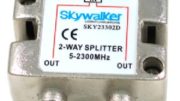Recently, one of our readers asked a question and immediately I knew they were in an apartment complex. How? They said they got DIRECTV and internet off the same wire. I also knew instantly that there was a problem. But, I’ll get to that in a moment.
Why is DIRECTV in an apartment special?
It’s special because the owners of the building want it to be. In the early days of satellite television, building owners hated DIRECTV and DISH. Installers from those companies drilled extra holes in walls and mounted dishes in unapproved places. There was an opportunity, so both DIRECTV and DISH developed solutions.
The most basic solution: a headend system
One of the easiest ways to get satellite TV into an apartment complex is a headend system. Headend systems use the exact same wiring scheme as cable TV companies. This makes installation easy. However, headend systems have some problems when compared to satellite TV. You don’t get all the channels satellite offers, there’s no DVR, and picture quality can be an issue.
While headend systems were pretty popular in the 1990s they are rarely seen today in apartment complexes.
A more common system: one dish per unit
The easiest solution to implement involves installing one dish per unit. This is also the solution that apartment building owners hate. A 20-unit apartment could have 20 dishes or more on the roof, and that could mean 150 more holes in the building or more. It also means that you don’t really have any control over what’s going on. Different installers can come in and cause havoc because they don’t know what’s going on in other apartments.
The real solution is called MFH.
MFH just really means “multi-family housing.” In the context of satellite TV, it means a solution that’s designed from the ground up to work with the needs of an apartment building. An MFH system can serve hundreds of units with a single dish. It can integrate internet over a single cable if needed. And, it can be maintained by a single installation company.
MFH systems have evolved so that today’s systems offer apartment dwellers the same choices as anyone else. In some cases, the equipment can stay in the unit and just be transferred to a new tenant. This cuts down on installation time and makes everyone happier.
One cable to rule them all
When the person who inspired this article told me they had internet and satellite on the same cable, I knew this was an apartment. I also knew something was wrong. In a properly installed MFH system, the internet and satellite data does travel on the same cable. But, that’s split out to two cables before the entry to the apartment. Special triplexers and filters are used to make sure that the internet signal doesn’t affect the satellite signal. Because this person said that one cable supplied it all, I knew that it wasn’t installed right.
But then… I couldn’t help
The advantage — or sometimes disadvantage — of an MFH system is that it’s assigned to one dealer. That one dealer has full responsibility for the system. In many cases they’re paid by the apartment owner to be available to fix problems. Unlike most DIRECTV installations, you can’t just call Solid Signal to get it fixed. (Unless we’re the ones who installed it.) You can’t call AT&T either. Should you call us or them, our computer systems will tell us that the system is maintained by someone else and we’ll have to send you over to those people.
If you’re in an apartment and need help, we can still offer new receivers and accessories, but we can’t do much for installation. If you’re not getting good service from your local satellite installer, tell the apartment manager. And, if they won’t listen, unfortunately your best option may be to move.
In the meantime, please do shop at Solid Signal for the best in satellite TV and accessories for homes, businesses, and even apartments.





